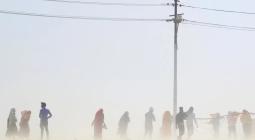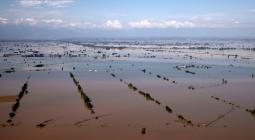Hailstorm frequency has increased by 40% around Sydney and Perth since 1979
Scientists say climate change may bring a decrease in frequency of hail activity but an increase in severity
The frequency of hailstorms has increased by about 40% around Sydney and Perth over the last four decades, while hail activity has decreased across much of the rest of the country, new research has found.
Scientists from the University of New South Wales and the Bureau of Meteorology analysed trends between 1979 and 2021, finding that hail-prone conditions had increased significantly over Australia’s south-east and south-west.
“This is the first time we’ve had a clear picture of how the hail climate across Australia is changing,” said the study co-author Dr Joshua Soderholm, a radar research scientist at the BoM.
The study’s first author, Dr Tim Raupach of the Climate Change Research Centre, said increases in hail frequency over Sydney, Canberra and Perth were mostly driven by atmospheric instability, which is determined by temperature and moisture.
“If the atmosphere is not … stable it’s prone to form updrafts,” Raupach said. Updrafts result in warm surface air being pushed up higher into the atmosphere. “It’s more buoyant than the cooler air and it starts to rise like a hot air balloon.”
Hailstones form via a combination of updrafts, moisture in the air, and cold enough temperatures high in the atmosphere. “The stronger the updraft is, the larger hailstone that can form,” Raupach said.
Wind shear – changes in horizontal wind direction or speed at different heights in the atmosphere – is also a factor. “When you have high wind shear, that causes storms to become more severe and more likely to form hail,” he added.
A decrease in wind shear across Australia’s mid-north over the four decades corresponded with a reduced frequency of hail-prone days, the researchers found.
Soderholm said: “In the north, there is lots of heat and humidity, but the wind shear is low, so it’s not ideal for hailstorms. In the south, we have too much wind but not enough heat and moisture. Our most frequent [hail storm] environments are around the Brisbane to Sydney region, because it’s an optimal balance.
“That climatic region – we’ve seen it in the trends starting to shift farther south. One explanation could be due to climate change.”
Though hail frequency has increased significantly around Perth over time, hailstorms over south-west Australia were far less frequent than over the south-east, Soderholm said.
The researchers analysed historical data of conditions favourable for hailstorms, as well as information from the BoM’s long-term weather radar archive.
Raupach said further research using climate projections was needed to determine how hail trends may change in the future with global heating.
“The broad view is that if the atmosphere is warmer, you might expect there to be more instability – so more generation of hail – but more melting of the hail as it falls towards the surface. So you might see a decrease in frequency … but an increase in severity.”
“But what we see from studies across the world … is that when you look at trends, information and simulations, they don’t always align with that broad expectation, because there’s so much geographical variability and there’s so many other factors that are in play.”
Previous research, co-authored by Raupach, has found that hailstorm frequency is generally expected to increase in Australia with climate change.
“One of the reasons that we’re interested in doing this research is to provide the information that could help with increasing resilience, whether that’s in cities where the materials that we build structures out of have an effect on how much damage you get from a hailstorm, or agricultural regions where farmers need to decide which crops to plant,” he said.
According to the Insurance Council of Australia, the costs of the 1999 Sydney hailstorm would amount to an estimated $8.85bn in insured losses if it occurred in 2023, outstripping the costs of the devastating 2022 south-east Queensland and New South Wales floods.
The study was published in the journal npj Climate and Atmospheric Science.
Photograph: Rohan Thomson/Getty Images - Increases in hail frequency over Sydney, Canberra and Perth were mostly driven by atmospheric instability, researchers say.





